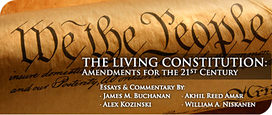On the 17th Amendment
To Prof. Amar: Let’s be careful about the phrase “state’s rights.” States do not have rights; only people have rights. State governments have only those powers authorized by their state constitutions and not prohibited to them by the federal Constitution. A repeal of the 17th Amendment would restore one state government power that, I suggest, was critical to the limitation of unauthorized federal powers for 124 years.
To Judge Kozinski: You are correct that the authors of the Federalist Papers, in making the case for the proposed Constitution, argued that the national government would be less subject to “faction” than would any individual state. Among the much larger number of members of the constitutional convention, however, there was only one vote against the provision that U.S. Senators would be selected by the state legislatures. The primary effect of this provision on fiscal responsibility is that it contributed to limiting the unauthorized expansion of federal powers. In 1913, the year in which the 17th Amendment was ratified, total federal outlays were 1.8% of GNP, almost all of which was for the military and the deferred costs of prior wars, and the total federal debt was 3.0% of GNP. Total federal outlays are now 20.3% of GNP, most of which is for programs for which there is no explicit constitutional authority, and the federal debt held by the public is now 36.4% of GNP.
On Constitutional Interpretation
The case for a strict interpretation of the Constitution is not dependent on a shared judgment that the Framers got everything right, either for their generation or ours, even though their political values and judgement were extraordinarily good. The primary case for a strict interpretation of the Constitution is to force the demands for constitutional change through the Article V processes for amending the Constitution. This would assure that any changes in the Constitution would reflect a very broad consensus. A change in the effective constitution, in contrast, now requires the approval of only the president, a majority of both houses of Congress, and a majority of the Supreme Court. In other words, we have politicized and democratized the process of constitutional change — to the point that the written Constitution is now no longer even a parchment barrier to constitutional change.
My thanks to all of you for your contributions to this dialogue.

